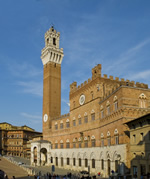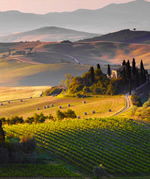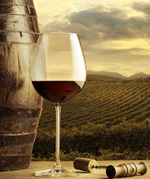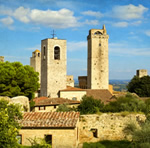These are some itineraries that we have selected for you. We wish you a good permanence in Tuscany:
Siena, San Gimignano, Montalcino, Monteriggioni, Pienza, Bagno Vignoni, Sant'Antimo, San Galgano.
For further info you can visit Tourism office website
Per facilitarvi la scelta e i percorsi abbiamo studiato 4 percorsi:

SIENA
Situated 322 m. above sea level in the heart of Tuscany, this town is built on three hills, maintaining intact its medieval appearance characterized by narrow winding streets and noble buildings.
Of Etruscan origin, it was a Roman colony with the name of Sena Julia; its importance grew in the Middle Ages, first as the seat of Lombard gastalds, and then of Counts under the Carolingian domination.
After a long period of episcopal dominion (9th-11th century) the town reached a peak of power after becoming a municipality (1147), undertaking a policy of expansion towards the bordering territories.
Confrontation with Florence was inevitable and the struggle lasted, with various vicissitudes, until 1555, when after a long siege, Siena was conquered by the Florentines, losing its autonomy and becoming part of the Duchy, sharing its fortunes until unification with Italy.
More informations wikipedia.it

THE CHIANTI
The Chianti region covers a vast area of Tuscany and includes within its boundaries several overlapping Denominazione di origine controllata (DOC) and Denominazione di Origine Controllata e Garantita (DOCG) regions. Other well known Sangiovese-based Tuscan wines such as Brunello di Montalcino and Vino Nobile di Montepulciano could be bottled and labeled under the most basic designation of "Chianti" if their producers chose to do so. Within the collective Chianti region more than 8 million cases of wines classified as DOC level or above are produced each year. Today, most Chianti falls under two major designations of Chianti DOCG, which includes basic level Chianti, as well as that from seven designated sub-zones, and Chianti Classico DOCG. Together, these two Chianti zones produce the largest volume of DOC/G wines in Italy.
The Chianti DOCG covers all the Chianti wine and includes a large stretch of land encompassing the western reaches of the province of Pisa near the coast of the Tyrrhenian Sea, the Florentine hills in the province of Florence to the north, to the province of Arezzo in the east and the Siena hills to the south. Within this regions are vineyards that overlap the DOCG regions of Brunello di Montalcino, Vino Nobile di Montepulciano and Vernaccia di San Gimignano. Any Sangiovese-based wine made according to the Chianti guidelines from these vineyards can be labelled and marked under the basic Chianti DOCG should the producer wish to use the designation.
Within the Chianti DOCG there are eight defined sub-zones that are permitted to affix their name to the wine label. Wines that are labeled as simply Chianti are made either from a blend from these sub-zones or include grapes from peripheral areas not within the boundaries of a sub-zone. The sub-zones are (clockwise from the north): the Colli Fiorentini which is located south of the city of Florence; Chianti Rufina in the northeastern part of the zone located around the commune of Rufina; Classico in the centre of Chianti, across the provinces of Florence and Siena; Colli Aretini in the Arezzo province to the east; Colli Senesi south of Chianti Classico in the Siena hills, which is the largest of the sub-zones and includes the Brunello di Montalcino and Vino Nobile di Montepulciano areas; Colline Pisane, the westernmost sub-zone in the province of Pisa; Montespertoli located within the Colli Fiorentini around the commune of Montespertoli; Montalbano in the north-west part of the zone which includes the Carmignano DOCG.[4] As of 2006, there were 786 acres (318.1 ha) under production in Montalbano, 2,236 (905 hectares) in the Colli Fiorentini, 140 (57 hectares) in Montespertoli, 1,840 (745 hectares) in Rufina, 8,780 (3,553 hectares) in the Colli Senesi, 380 (154 hectares) in Colline Pisane, 1,603 (649 hectares) in the Colli Aretini, and an additional 25,511 (10,324 hectares) in the peripheral areas that do not fall within one of the sub-zone classifications. Wines produced from these vineyards are labelled simply "Chianti".
More informations wikipedia.it

FOOD AND WINE TOUR
Pienza, Montepulciano and Montalcino, (jewels of Val d'Orcia), every year welcome thousands of visitors to the discovery their innumerable attractions.
Built by Pope Pius II, from which it takes its name, Pienza is a rare example of beauty, harmony and architectural perfection. The many little alleys with evocative names (Via del Bacio, Way of Love ...), overlooking on breath-taking scenery. The squares and historical buildings preserve the secrets of Rossellino. The taste, the smell and the taste support the artistic and natural heritage. Pecorino di Pienza is a traditional product that you can enjoy lunch at one of the restaurants in the town.
The tour continues to Montepulciano, a town surrounded by massive walls.
The splendour of Renaissance palaces and the elegant beauty of its churches are united with the ancient tradition of wine "Nobile di Montepulciano", the symbol of the city.
The town of Montalcino, sanctuary of this wine produced from Sangiovese grapes, stands on a charming hill that will let you relish its natural wholesomeness. The town, its century-old fortress and the best wineries reviewed on specialised magazines are the main destination of thousands of tourists every year. Great skill in the cellar, wich includes a long maturation in casks made from valuable wood, make Brunello, holder of the title of “Italian ambassador in the world of our winemaking realty”, the most highly regarded wine in the world.

SAN GIMIGNANO
San Gimignano rises on a hill (334m high) dominating the Elsa Valley with its towers.
Once the seat of a small Etruscan village of the Hellenistic period (200-300 BC) it began its life as a town in the 10th century taking its name from the Holy Bishop of Modena, San Gimignano, who is said to have saved the village from the barbarian hordes.
The town increased in wealth and developed greatly during the Middle Ages thanks to the "Via Francigena" the trading and pilgrim's route that crossed it. Such prosperity lead to the flourishing of works of art to adorn the churches and monasteries.
On the 8th May 1300 Dante Alighieri came to San Gimignano as the Ambassador of the Guelph League in Tuscany. In 1348 San Gimignano's population was drastically reduced by the Black Death Plague throwing the city into a serious crisis.
In the following centuries San Gimignano overcame its decline and isolation when its beauty and cultural importance were rediscovered.

SPA
The province of Siena is rich in thermal springs. The thermal baths of Siena are stunning and unique for the combination of which offer excellent climate and incomparable scenery. The landscape and the environment increase the beneficial effects of thermal waters. The spas also have numerous therapeutic properties and other: you can choose between beauty treatments, rehabilitation and treatments for respiratory diseases.
The spas date back to the Etruscan and Roman periods, when the spa waters were an essential element in the social life of the city. The spa of Siena, in Tuscany, have the great fortune to be close to major centers of art and culture. In the province of Siena, there are many spas to visit: Rapolano Terme, Bagni di Petriolo, Bagni di San Filippo, Bagno Vignoni, Chianciano and Montepulciano.



